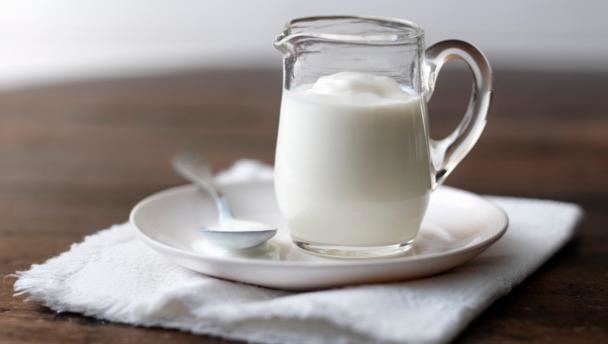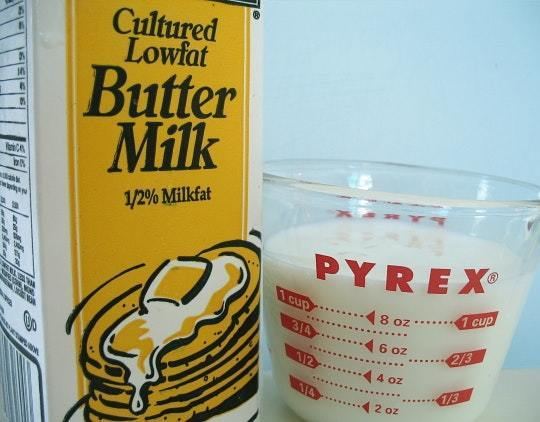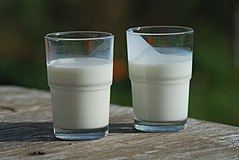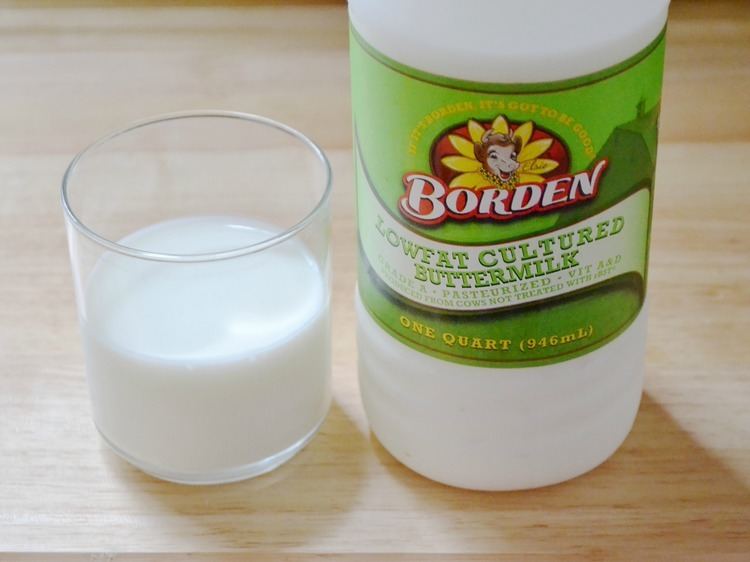Energy 169 kJ (40 kcal) Fat 0.9 g Calcium (12%)116 mg | Carbohydrates 4.8 g Protein 3.3 g | |
 | ||
Similar Milk, Sugar, Red velvet cake, Butter, Pancake | ||
Masala buttermilk health drink during pregnancy mallika badrinath recipes
Buttermilk refers to a number of dairy drinks. Originally, buttermilk was the liquid left behind after churning butter out of cream. This type of buttermilk is known as traditional buttermilk.
Contents
- Masala buttermilk health drink during pregnancy mallika badrinath recipes
- Ayurvedic buttermilk the ultimate digestive drink
- Traditional buttermilk
- Cultured buttermilk
- Acidified buttermilk
- Powdered buttermilk
- Nutrition
- References

The term buttermilk also refers to a range of fermented milk drinks, common in warm climates (e.g., the Balkans, the Middle East, Turkey, Afghanistan, Pakistan, Nepal, India, Sri Lanka, Nicaragua and the Southern United States) where unrefrigerated fresh milk sours quickly, as well as in colder climates, such as Scandinavia, Ireland, the Netherlands, Germany, Poland, Slovakia, Slovenia, Croatia and Czechia. This fermented dairy product known as cultured buttermilk is produced from cow's milk and has a characteristically sour taste caused by lactic acid bacteria. This variant is made using one of two species of bacteria—either Lactococcus lactis or Lactobacillus bulgaricus, which creates more tartness.

The tartness of buttermilk is due to acid in the milk. The increased acidity is primarily due to lactic acid produced by lactic acid bacteria while fermenting lactose, the primary sugar in milk. As the bacteria produce lactic acid, the pH of the milk decreases and casein, the primary milk protein, precipitates, causing the curdling or clabbering of milk. This process makes buttermilk thicker than plain milk. While both traditional and cultured buttermilk contain lactic acid, traditional buttermilk tends to be less viscous, whereas cultured buttermilk is more viscous.

Buttermilk can be drunk straight, and it can also be used in cooking. Soda bread is a bread in which the acid in buttermilk reacts with the rising agent, sodium bicarbonate, to produce carbon dioxide which acts as the leavening agent. Buttermilk is also used in marination, especially of chicken and pork, whereby the lactic acid helps to tenderize, retain moisture, and allows added flavors to permeate throughout the meat.

Ayurvedic buttermilk the ultimate digestive drink
Traditional buttermilk
Originally, buttermilk referred to the liquid left over from churning butter from cultured or fermented cream. Traditionally, before cream could be skimmed from whole milk, the milk was left to sit for a period of time to allow the cream and milk to separate. During this time, naturally occurring lactic acid-producing bacteria in the milk fermented it. This facilitates the butter churning process, since fat from cream with a lower pH coalesces more readily than that of fresh cream. The acidic environment also helps prevent potentially harmful microorganisms from growing, increasing shelf-life. However, in establishments that used cream separators, the cream was hardly acidic at all.

On the Indian subcontinent, the term "buttermilk" refers to the liquid left over after extracting butter from churned cream. Today, this is called traditional buttermilk. Traditional buttermilk is still common in many Indian, Nepalese, and Pakistani households, but rarely found in Western countries.
It can be easily made at home though, by simply shaking a cup of non-homogenized (e.g. organic) cream until it separates into butter and buttermilk.
In Southern India and in the states of Punjab, Gujarat and Rajasthan, buttermilk topped with sugar, salt, cumin, asafoetida, or curry leaves is a common accompaniment in every meal.
Cultured buttermilk
Commercially available cultured buttermilk is milk that has been pasteurized and homogenized (with 1% or 2% fat), and then inoculated with a culture of Lactococcus lactis plus Leuconostoc citrovorum to simulate the naturally occurring bacteria in the old-fashioned product. Some dairies add colored flecks of butter to cultured buttermilk to simulate residual flecks of butter that can be left over from the churning process of traditional buttermilk.
Cultured buttermilk, often known simply as "buttermilk", was first commercially introduced in the United States in the 1920's. It was popular among immigrants, and viewed as an a food that could slow aging. It reached peak annual sales in 1960. Buttermilk's popularity has declined since then, and now annual sales reach less than half that number.
Condensed buttermilk and dried buttermilk have increased in importance in the food industry. Buttermilk solids are used in ice cream manufacturing, as well as being added to pancake mixes.
Acidified buttermilk
Acidified buttermilk is a related product made by adding a food-grade acid (such as lemon juice) to milk. It can be produced by mixing 1 tablespoon of vinegar or lemon juice per 1 cup of milk and letting it sit until it curdles, about 10 minutes. Any level of fat content for the milk ingredient may be used, but whole milk is usually used for baking. In the process which is used to produce paneer, such acidification is done in the presence of heat.
Powdered buttermilk
Like powdered milk, buttermilk is available in a dried powder form. This stores well at room temperature and is usually used in baked goods.
Nutrition
One cup (237 mL) of whole milk contains 157 calories and 8.9 grams of fat whereas one cup of buttermilk contains 99 calories and 2.2 grams of fat. Buttermilk contains vitamins, potassium, calcium, and traces of phosphorus.
